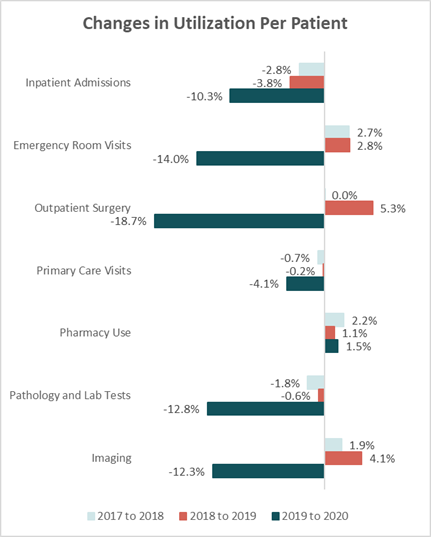MN Community Measurement’s annual health care cost report illustrates pandemic’s impact on cost, utilization of services
MINNEAPOLIS (November 16, 2021) – MN Community Measurement (MNCM), an independent nonprofit organization that empowers health care decision makers with meaningful data to drive improvement, has released its annual report comparing health care costs, utilization, and prices across medical groups in Minnesota.
The Health Care Cost & Utilization in 2020 report highlights overall cost trends in 2020 for Minnesotans with private health insurance coverage. Using data for over 1.3 million people with a total of $9.1 billion in health care spending, the report compares results for 108 medical groups. An appendix to the report includes detailed information on cost and utilization by medical group. Key findings in the report include the following:

• Statewide, the total cost of care (TCOC) for people with private insurance fell by 2.5 percent per person in 2020, after increasing by an average of 5.0 percent per year for the previous five years.
• Costs per person for outpatient hospital services fell the most (8.4 percent), followed by inpatient hospital services (5.2 percent), and professional services (3.7 percent). Pharmacy costs, however, increased by 11.1 percent per person, which was the fastest rate of increase since MNCM began publishing this report in 2014.
• Although costs fell in all regions of the state, the amount varied by region. The largest decline was for people living in the Mankato area, whose total costs fell by 7.4 percent. The smallest decline was for people living in the Brainerd area, whose costs fell by 0.2 percent.
• As shown in the chart to the right, utilization of services among people with private health insurance fell in 2020, with double digit declines in utilization of outpatient surgery (18.7 percent), emergency room visits (14.0 percent), pathology and lab tests (12.8 percent), imaging (12.3 percent), and inpatient hospital admissions (10.3 percent). Pharmacy was the only service category where utilization increased, by 1.5 percent compared to 2019.
• Paradoxically, there was a slight increase in the percentage of commercial health plan members who had any use of health care services in 2020 compared to 2019. Overall, the percentage of people with any health care service use increased from 87.5 percent to 88.2 percent, with the largest increase among younger adults. Children were the only age group that showed a decline in the percentage of people with any health care service use (from 91.0 percent to 88.8 percent).
“Given the many disruptions to health care in 2020, it’s not surprising to see that costs fell,” said Julie Sonier, President and CEO of MN Community Measurement. “However, we don’t yet know about the implications of the care that was forgone in 2020 for future health outcomes and health care costs. This story is still unfolding, and it will take at least a few years to understand the long-term implications.”
“This information is valuable because it helps health care providers know where they stand relative to their peers on health care cost and utilization,” said Mark Matthias MD, Physician Vice President of Acute Care at CentraCare and chair of MN Community Measurement’s Board of Directors. “Lower utilization and cost in 2020, most likely the result of delaying care, is evident in trends that we’re seeing this year with patients who are presenting with more advanced illness than in the past. This is a challenge that all health care providers are experiencing.”
“The pandemic has complicated our ability to draw conclusions about cost trends, but MNCM’s annual report provides transparency and helps reveal areas of opportunity,” said Dr. Patrick Courneya, chief health plan medical officer at HealthPartners and member of the MNCM Board of Directors. “The 2020 report, along with previous and future reports, gives us trusted and actionable insights into how medical groups can achieve our shared goal of more affordable health care.”
Health plans that participated in MNCM’s TCOC analysis for 2020 include Blue Cross Blue Shield of Minnesota, HealthPartners, Medica Health Plans, and PreferredOne.
Importance of Measurement
Measuring and reporting on health care cost and quality is important because it helps consumers know how cost and care vary across providers, and it helps providers to understand how their results compare to others and where their biggest improvement opportunities are. Measuring and reporting also help health plans and other purchasers better understand and improve value for money that is spent on health care.
“Minnesota is really unique in the nation in the capabilities we’ve built to measure and report on health care cost, quality, and equity,” said Sonier. “Because we work with all stakeholders and do our work using objective, transparent methods, we’re able to serve as a trusted source of information on health care cost and quality.”
About MN Community Measurement
MN Community Measurement (MNCM) is a nonprofit organization dedicated to empowering health care decision makers with meaningful data to drive improvement. A trusted source of health care data since 2005, MNCM works with doctors, hospitals, clinics, insurance companies, and state agencies to collect, analyze, and report health care data related to health care quality and cost. Learn more at www.mncm.org.
